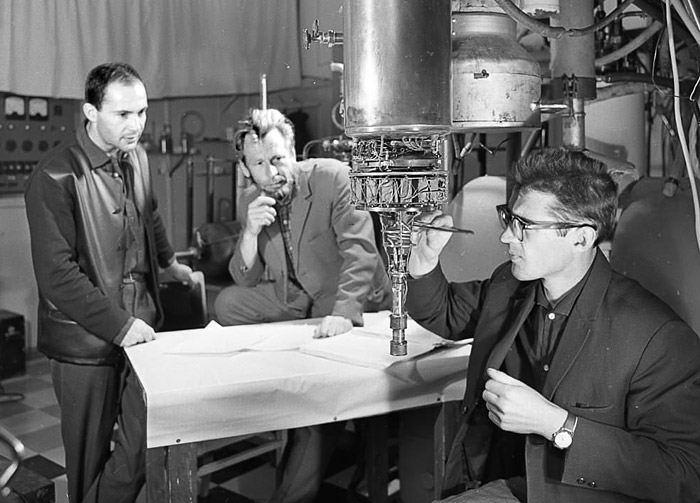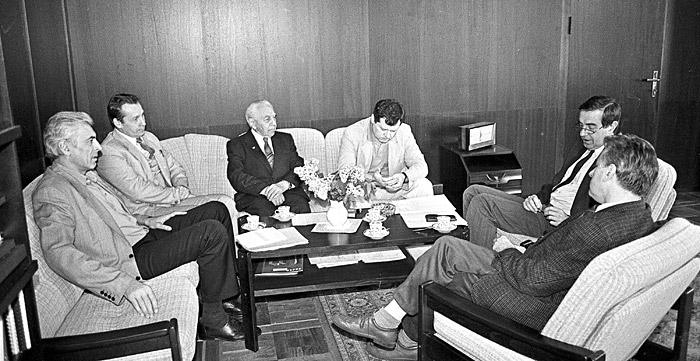
Electronic english version since 2022 |
The newspaper was founded in November 1957
| |
The team and its work
Ultralow temperatures in spin physics
From the history of a sector
The subject of polarization research is the investigation of the dependence of interactions on the spins of the particles involved. Spin was introduced into science almost 100 years ago to describe atomic spectra, yet its nature is still an unsolved mystery.
The occurrence of polarization experimental data has stimulated the theoretical understanding of spin effects and has served as a "testing ground" for theoretical models. In this sense, the statements of well-known theorists are typical, such as of the Englishman Elliot Lieder: "Spin has killed more theories in experiments than any other physical parameter," or the American James Bjorken: "Polarization data have often been a graveyard of fashionable theories. If the theorists had their way, in self-protection they should have banned such measurements altogether." A clear illustration of these "theoretical" statements can be seen in the work of one of the departments of the Dzhelepov Laboratory of Nuclear Problems.
Actually, the history of the Sector of Low Temperatures (SLT) dates back to the time when JINR’s first polarized target of the dynamic type was developed and built by the specialists of two JINR laboratories, the Laboratory of Nuclear Problems (LNP) and the Laboratory of Neutron Physics (LNPh). In polarized targets of this type, dynamic polarization of target nuclei has to be a continuous process to support the achieved level of polarization, since polarization relaxation processes at temperatures of about 1 K are quite intensive, making it impossible to carry out physical measurements without continuously pumping (maintaining) polarization. That was a real innovation, like much other of the work done at that time!
It involved overcoming cryogenic and vacuum problems, finding appropriate microwave sources, and developing instruments for measuring nuclear polarization of the target and other necessary equipment for this kind of setup. The corresponding publication (V. L. Luschikov, B. S. Neganov, L. B. Parfenov and Yu. V. Taran, Sov. Phys. JETP, 22 (1966) 285) ushered in the development boost of cryogenic technology as a response to the demands of rapidly developing spin physics
The first polarized target of this type was created in 1962 by French scientists headed by Anatole Abragam, who did not become a Noble Laureate through pure chance (to my mind). A. Abragam (born to a family of Baltic Jews), whose life was not a bed of roses, visited JINR in the early 1970s (probably, wishing to see the dynamic polarized target operating at the LNP synchrocyclotron). In the experimental hall, one of the coauthors of our target began telling A. Abragam about the setup. After a short time, A. Abragam interrupted him and asked in very good Russian, what was the language he spoke. Indeed, lacking practice, our specialists had a poor command of foreign languages, but this did not hinder them from working skillfully and successfully. Later, it was Abragam’s laboratory where one of the coauthors (V. L. Lushchikov) was invited to work as a visiting scientist for one year.
In about 1964, two Moscow State University students, N. S. Borisov and M. Yu. Liburg, joined Neganov’s group and were given an opportunity to put into practice a «fresh» idea of producing ultralow temperatures by a new method, which was published in 1962 (London, Clarke and Mendoza, Phys. Rev. 128, 1962). This publication was brought just in time by Czechoslovakian physicist S. Safrata, who worked in the journal Cryogenics for a long time and had access to information like that. Clearly, there were many who knew about it, and two more attempts to implement the idea were made in different places at approximately the same time. The results showed that Neganov’s group succeeded best. Even at their earliest steps the record temperature of 50 mK was achieved!

M.Yu.Liburg, B.S.Neganov, and N.S.Borisov by the first setup for producing ultralow temperatures, 1966
It was also lucky for the coauthors that the chaired by Pyotr Leonidovich Kapitsa was held in Moscow in 1966, and B. S. Neganov had a good opportunity to talk to an international expert audience about the new method for production of ultralow temperatures. The legend is that after the talk which became a real scientific sensation, Pyotr Leonidovich said that the Scientific Council of the Institute of Physical Problems would consider it an honor to approve the defense of the doctoral dissertation by B. S. Neganov. It took some time to improve the method, and in 1968 the then lowest temperature of 5.5 mK was obtained by this method at LNP. This result entered physics handbooks all over the world.
Later, ultralow temperatures will be indissolubly linked to such a field of experimental physics as investigations of polarized phenomena. Polarization investigations are concerned with studying dependence of interactions on spins of participating particles. The notion of spin was introduced into scientific discourse almost 100 years ago to describe atomic spectra, but its nature is still obscure.
When appeared, experimental polarization data stimulated theoretical comprehension of spin effects and served as a testing ground for verifying theoretical models. Characteristic in this sense are statements of the known theorists — «Experiments with spin have killed more theories than any other single parameter» by Englishmen Elliot Leader and — «Polarization data has often been the graveyard of fashionable theories. If theorists had their way, they might well ban such measurements altogether out of self-protection» by American James Bjorken.
In 1973, the LNP Directorate took a decision to develop a polarized target of a new type. This means a target of the «frozen» type, which uses to the full the effect of cooling the target material to ultralow temperatures of ~20-30 mK. That it was possible in principle was earlier asserted by B. S. Neganov.
The only thing to do was to adapt the achievements in production of ultralow temperatures to the purposes of developing the experimental equipment, that is, polarized targets of the frozen type that would take full advantage of the opening possibilities. In 1975, the first (world's first, as turned out later) was used at the LNP synchrocyclotron in the experiment on the investigation of polarization effects in pp interactions at 500 to 630 MeV.
That was the first use of the new method for producing ultralow temperatures in experimental physics.
In 1977, an ultralow-temperature setup for studying short-lived nuclei was developed at the SLT with the decisive participation of V. N. Pavlov. It allowed the LNP Radiochemical Laboratory (RCL) to implement its vast research program. Surprisingly soon, in 1978, the second polarized target of the frozen type, was made specially for the research at the Institute of High-Energy Physics (IHEP) in Protvino.
In those years, several large experiments (PROZA, HYPERON, RISK) were simultaneously carried out at our Department of Hadron Physics (DHP). Also, each year, our scientists participated in experiments at the U-70 accelerator, which usually took two to three months. By that time, the physics program with beams and the first frozen polarized target had been finished, and the setup was moved to the Sector building.
Soon physicists of the Leningrad Institute of Nuclear Physics (LINP) (including V. G. Vovchenko) and the head of our Department Yu. M. Kazarinov proposed a polarization research program to be carried out at LINP, which required delivering the polarized target to Gatchina. This dramatic transport of a such a delicate experimental setup as the polarized target was the first in our experience, and extraordinary safety measures were taken. They justified themselves, and two or three months later experiments were started at the LINP accelerator. And considering that in mid-August 1978 experiments with the new polarized target began at IHEP, it becomes clear how tough the schedule of the Sector staff was at that time.
The staff members of the Sector were constantly busy participating in polarized target runs both in Protvino and in Gatchina. Over time, they established their own group for polarized target studies in Gatchina, and our participation in that work almost stopped. At IHEP, nothing of the kind has happened, and our participation has been going on with a few interruptions up to now.
Moreover, this long work has resulted in a renewed SPASCHARM project (SPin ASymmetries in CHARMonium production). The project is aimed at investigating the nucleon spin structure and the spin dependence of the strong interaction between antimatter and matter at energies of up to 50 GeV.
It is intended to produce polarized proton and antiproton beams, which will allow spin-related challenges to be solved at the SPASCHARM facility. Apart from polarized beams, it is planned to create a polarized solid target with frozen nucleon spins for this project. Also, it is supposed that the JINR team (Sector of Low Temperatures) with its unique experience and achievements in this field (similar operating facilities in Gatchina, Protvino, Prague, and Mainz) will play a leading part in these activities.
Undoubtedly, it is necessary that IHEP specialists and Germain colleagues (from Universities of Mainz and Bonn) take an active part in the SPASCHARM project. The use of the already manufactured units and general technologies for the main detectors will contribute to higher fruitfulness and efficiency of this cooperation.
Now a special team of theoretical physicists is being established for theoretical support of the SPASCHARM experiment. This is important for searching for spin effects in certain kinematic regions where theoretical models developed by this team will predict their existence. Thus, the experiments will not be carried out blindly.
The future polarized-beam facility has no analogues in the world. The expected period of its being unique is at least 15 years. If implemented, this research will allow the participants to have a world lead in spin physics.
The real international collaboration began for us with the proposal of Czechoslovakian scientists and physicists from Yu. M. Kazarinov’s sector to develop a frozen polarized target specially for experiments at low energies of ~15 MeV. That was the energy of the polarized neutron beam from the Van de Graaff (VdG) accelerator at Charles University in Prague.
We could never imagine how many problems would arise from our decision to take part in the project. With our experience of creating the experimental facilities operating in Gatchina and Protvino, so serious problems in implementation of our plans in Prague were hardly expectable.
First, we had to come to Prague with a «half-made» facility and complete the work on it under quite different conditions using quite different resources. All this seriously hampered our further work, which resulted in that the polarized target was put into operation at the VdG accelerator only in 1994.
Among the difficulties we encountered in Prague was a radical change in the political system (in 1989) and, accordingly, in the attitude to us as representatives of the USSR, the country that suddenly turned to be to blame for everything. But our relations with the nearest colleagues remained,and still are, very good, which allowed us to jointly establish a precedent of organizing the only beam experiment in a JINR Member State.
Paradoxically, JINR scientists participate in accelerator experiments all over the world but not in JINR Member States. These «precedents» serve the purpose of one of the main clauses of the JINR Charter — development of the relevant fields of physics in Member States. To carry on with the adopted experimental polarization program, the work on increasing neutron beam polarization (proposal of SLT researcher Yu. A. Plis) is underway at the VdG accelerator in Prague, and preliminary encouraging results have already been obtained.

Discussing the plan of joint activities at the VdG
accelerator of Charles
University in Prague, 1994.
Left to right: I. Wilhelm, rector of Charles
University in Prague;
Yu. A. Usov, LNP researcher; V. P. Dzhelepov, Honorary Director
of LNP; N. A. Rusakovich, Director of LNP;
R. Mach, Plenipotentiary of the Czech Republic; M. Finger, Head of
Department of LNP
To be continued.
Yury USOV, Head of the Sector of Low Temperatures of DLNP